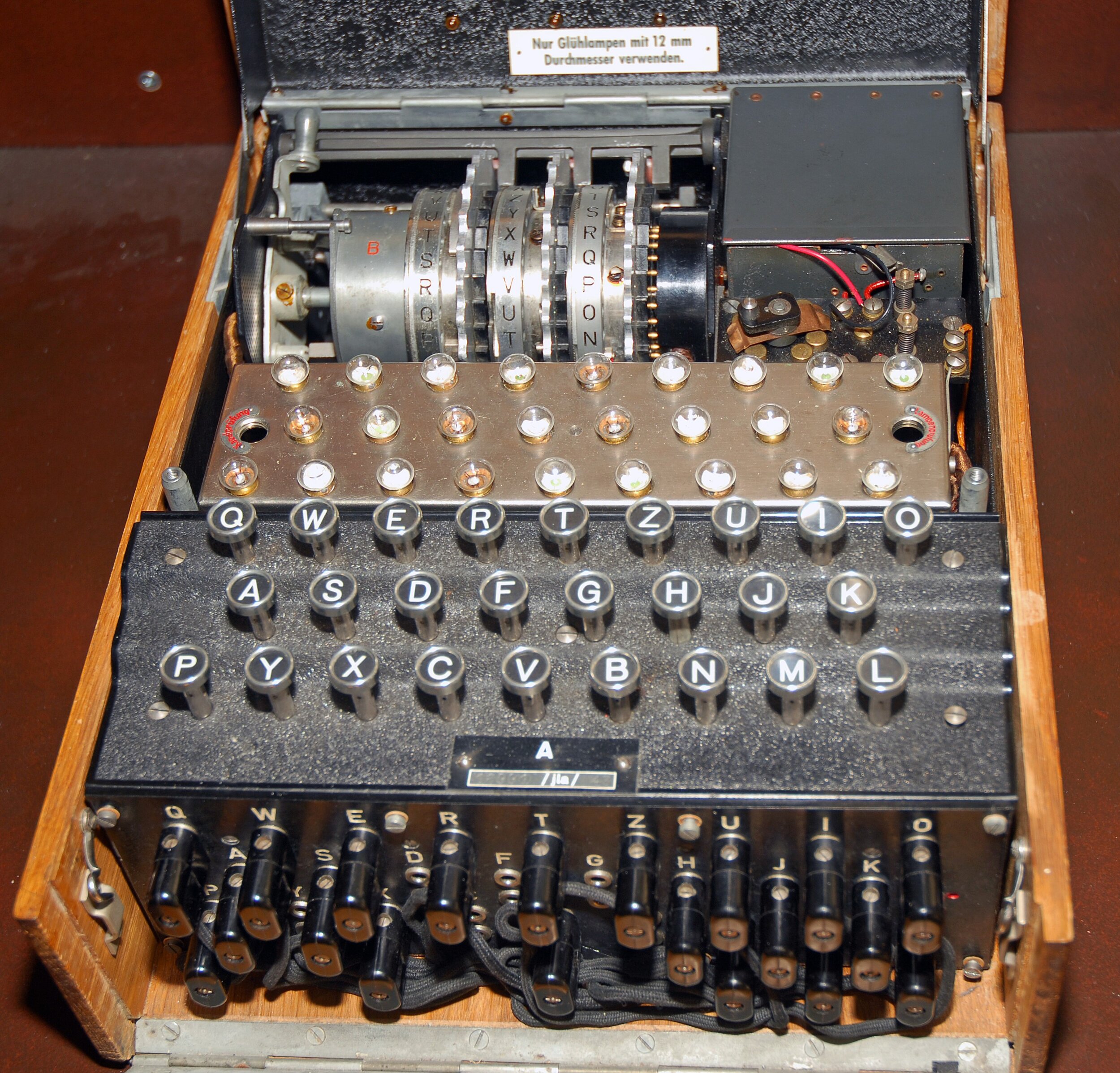2 - The Enigma Machine
Enigma was the trade name of the cipher machine used by the German armed forces, the security and intelligence organisations and the railways during World War Two. There were variations on the machine, particularly from February 1942, when the U-boat fleet adopted a four-wheel version. However, the standard machine used three wheels.
Figure 3 A standard three-wheel Enigma machine showing the wheels (top), reflector to the left and the black entry wheel to the right, lampboard (note small light bulbs), keyboard and (front) plugboard
The machine was given the brand name Enigma by German engineer Arthur Scherbius, who developed it for commercial use, minus the plugboard, after World War One.
In 1926 the German Navy adopted it, followed two years later by the Army, then by the Air Force in 1935. It was the military who added the all-important plugboard as an added security device.
The machine used by the Army and Air Force had a set of five wheels, each with a different scrambling pattern, of which three would be used each day.
The Navy had eight wheels, and only they used these three extra wheels. The wheels could be removed and changed. The daily settings were contained in a monthly ‘key sheet’ provided to the individual networks of the German armed forces, and there were hundreds of these networks throughout the war, although only about 50 were operational at any time. When two or more machines were correctly set up on a network they were reciprocal – a message could be encrypted and decrypted without changing the settings.
The wheels had individual internal wiring together of the 26 letters of the alphabet and were stamped on the back with Roman numerals. They were listed in the key sheet from left to right, e.g., IV III V – left, middle and right-hand wheels. Each wheel had the letters of the alphabet (Navy) or numbers 1-26 (Army and Air Force) round a ‘tyre’ on the wheel, which could be moved relative to the core of the wheel when a clip was pulled out.
This tyre had a notch in it which engaged with the turnover mechanism. Naval wheels VI, VII and VIII had two notches.
The clip would be put back into the ring-setting (ringstellung) for the day on each wheel, e.g., L V X, which determined where the notch which turned over the wheel to the left of it would be activated. At every depression of a letter on the keyboard, the wheel wiring position changed. A turnover changed it again.
There was a keyboard to encipher/decipher the message and a lampboard behind it which lit up the enciphered or deciphered letter. The plugboard (stecker) also contained the letters of the alphabet and two-way jacks were used to plug up 20 out of the 26 letters in pairs – e.g., D plugged to V, J plugged to Z, etc. This left six letters unplugged or ‘self-steckered’.
The wheel order, ringstellung and stecker comprised the day’s ‘key’. It was this ‘key of the day’ which Bletchley Park was seeking to find using the Bombe. To the left of the wheels was a reflector (Umkehrwalze) and to their right an entry wheel (eintrittwalze) – both fixed. When a key on the keyboard was pressed, current from that key passed through its plugboard pairing to the entry wheel, the scrambler wheels, the reflector, back again through the scrambling wheels, through another plugboard pairing and to a lamp.
Figure 4 - The parts and internal wiring of an Enigma wheel
The right-hand wheel moved on each keyboard stroke prior to enciphering. Once per complete revolution the right-hand wheel notched caused the middle wheel to move by one letter. The middle wheel turned over the left-hand wheel after it, too, had covered the full 26 letter circuit. For each message sent, the sending operator picked an ‘indicator setting’ and an ‘indicator’ each comprising three randomly chosen letters.
The indicating setting was sent in the Morse message in clear. The operator moved his wheels so that these three letters could be seen in the machine’s window. Then he enciphered the indicator at this indicator setting and sent its enciphered form in the Morse message. The operator then set his chosen indicator in the window and enciphered the message.
So, although these two trigrams could easily be spotted by the codebreakers, unless the key of the day was known, the information was useless. Around 3,000-5,000 Enigma enciphered messages a day came into Bletchley Park. Not all were broken, some took days, some weeks, others were broken within 24 hours, some never – early breaking was crucial if the codebreakers were to decrypt messages while the information was still current.
(c) John Jackson




